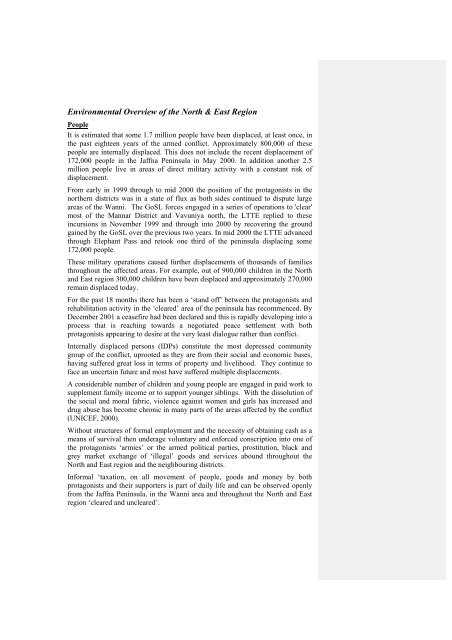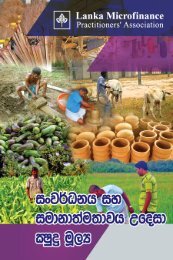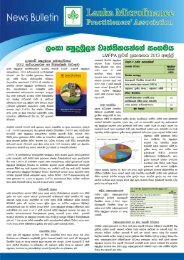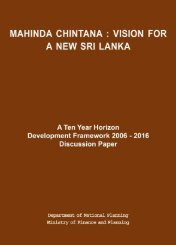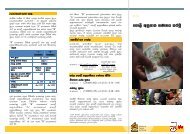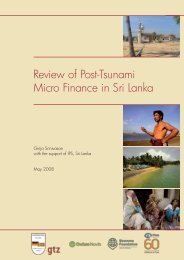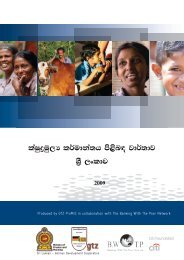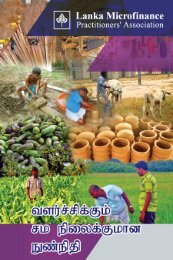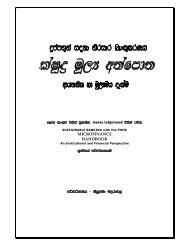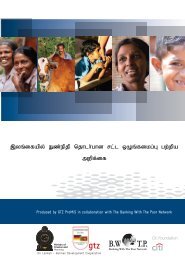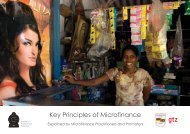National Microfinance Study of Sri Lanka: Survey of Practices and ...
National Microfinance Study of Sri Lanka: Survey of Practices and ...
National Microfinance Study of Sri Lanka: Survey of Practices and ...
Create successful ePaper yourself
Turn your PDF publications into a flip-book with our unique Google optimized e-Paper software.
Environmental Overview <strong>of</strong> the North & East Region<br />
People<br />
It is estimated that some 1.7 million people have been displaced, at least once, in<br />
the past eighteen years <strong>of</strong> the armed conflict. Approximately 800,000 <strong>of</strong> these<br />
people are internally displaced. This does not include the recent displacement <strong>of</strong><br />
172,000 people in the Jaffna Peninsula in May 2000. In addition another 2.5<br />
million people live in areas <strong>of</strong> direct military activity with a constant risk <strong>of</strong><br />
displacement.<br />
From early in 1999 through to mid 2000 the position <strong>of</strong> the protagonists in the<br />
northern districts was in a state <strong>of</strong> flux as both sides continued to dispute large<br />
areas <strong>of</strong> the Wanni. The GoSL forces engaged in a series <strong>of</strong> operations to 'clear'<br />
most <strong>of</strong> the Mannar District <strong>and</strong> Vavuniya north, the LTTE replied to these<br />
incursions in November 1999 <strong>and</strong> through into 2000 by recovering the ground<br />
gained by the GoSL over the previous two years. In mid 2000 the LTTE advanced<br />
through Elephant Pass <strong>and</strong> retook one third <strong>of</strong> the peninsula displacing some<br />
172,000 people.<br />
These military operations caused further displacements <strong>of</strong> thous<strong>and</strong>s <strong>of</strong> families<br />
throughout the affected areas. For example, out <strong>of</strong> 900,000 children in the North<br />
<strong>and</strong> East region 300,000 children have been displaced <strong>and</strong> approximately 270,000<br />
remain displaced today.<br />
For the past 18 months there has been a ‘st<strong>and</strong> <strong>of</strong>f’ between the protagonists <strong>and</strong><br />
rehabilitation activity in the ‘cleared’ area <strong>of</strong> the peninsula has recommenced. By<br />
December 2001 a ceasefire had been declared <strong>and</strong> this is rapidly developing into a<br />
process that is reaching towards a negotiated peace settlement with both<br />
protagonists appearing to desire at the very least dialogue rather than conflict.<br />
Internally displaced persons (IDPs) constitute the most depressed community<br />
group <strong>of</strong> the conflict, uprooted as they are from their social <strong>and</strong> economic bases,<br />
having suffered great loss in terms <strong>of</strong> property <strong>and</strong> livelihood. They continue to<br />
face an uncertain future <strong>and</strong> most have suffered multiple displacements.<br />
A considerable number <strong>of</strong> children <strong>and</strong> young people are engaged in paid work to<br />
supplement family income or to support younger siblings. With the dissolution <strong>of</strong><br />
the social <strong>and</strong> moral fabric, violence against women <strong>and</strong> girls has increased <strong>and</strong><br />
drug abuse has become chronic in many parts <strong>of</strong> the areas affected by the conflict<br />
(UNICEF, 2000).<br />
Without structures <strong>of</strong> formal employment <strong>and</strong> the necessity <strong>of</strong> obtaining cash as a<br />
means <strong>of</strong> survival then underage voluntary <strong>and</strong> enforced conscription into one <strong>of</strong><br />
the protagonists ‘armies’ or the armed political parties, prostitution, black <strong>and</strong><br />
grey market exchange <strong>of</strong> ‘illegal’ goods <strong>and</strong> services abound throughout the<br />
North <strong>and</strong> East region <strong>and</strong> the neighbouring districts.<br />
Informal ‘taxation, on all movement <strong>of</strong> people, goods <strong>and</strong> money by both<br />
protagonists <strong>and</strong> their supporters is part <strong>of</strong> daily life <strong>and</strong> can be observed openly<br />
from the Jaffna Peninsula, in the Wanni area <strong>and</strong> throughout the North <strong>and</strong> East<br />
region ‘cleared <strong>and</strong> uncleared’.


